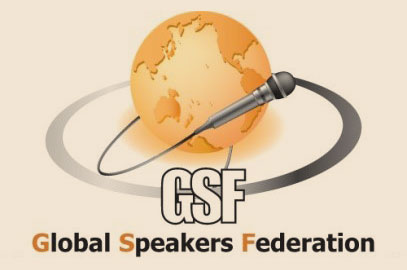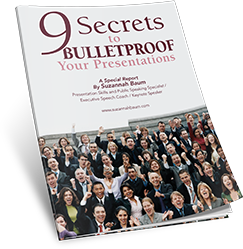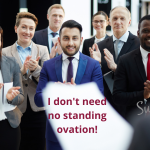Why ‘Very Good’ Isn’t Good Enough When it Comes to Public Speaking (Guest Post)
This is a guest post by Samuel Eddy, the man behind Open Change Workplace Wellness. Through his company he combines his counselling background and corporate experience to deliver keynote speeches and corporate programs that promote positive ways to combat anxiety, stress and disruption in the workplace. Communication is key is a mantra that Sam is committed to, both in practice and in content.
Three in four people experience some form of anxiety when it comes to public speaking.
That means that there is a better than average chance you have some sort of anxiety when it comes to public speaking. Also, if you have found your way to this blog, you probably have some call to deliver a speech, or speeches in front of large groups of people. There is a significant overlap of people in this world who are intimidated by public speaking and those that are called to do it on a regular basis.
While talking in front of a crowd is not as threatening as facing a great white shark or sky-diving 12,000 feet, it is much more likely it is a fear you will have to confront at some time in your life.
Most people do.
And it is scary.
And if you have had to do it on a regular basis you probably would have coped by quickly learning the language of public speaking. How to open a speech; how to lead into your primary point; and how to sum everything up.
You will have become, by all measures, a very good public speaker.
Unfortunately, if you want to make an impact with what you say, being ‘very good’ at public speaking is exactly the opposite of what you actually want.
Why ‘very good’ is the opposite of excellent.
Now, maybe I am already guilty of going a bit overboard.
When, I say ‘very good’ is the opposite of what you should be aiming for in your public speaking, I am only referring to cases when you want your audience to really remember what you have to say.
And I say this without meaning to be facetious. There are plenty of situations where a speech you might have to deliver is only a necessary side product of your main goal.
I run a business called Open Change which is primarily concerned with discussing workplace wellbeing in a corporate setting. In my situation, when I deliver a keynote speech or run a workplace workshop, the speech I deliver to my audience is the actual point of what I am doing. If my audience don’t absorb the ideas I am talking about, there is no point to what I have done.
And if all I do is produce a ‘very good’ speech, I will likely find myself in a situation where they may listen intently, but they probably won’t remember a single thing I have said more than a few days later.
Why? Because people don’t remember ‘very good’. They remember exceptional. They remember horrendous. Everything else is just white noise
How to be an exceptional public speaker.
1. Risk being horrendous
The main reason being ‘very good’ is such a forgettable strategy is because it is safe
Here is a more tangible example: unless it was in the last couple of weeks you probably couldn’t pinpoint the last time you had vanilla ice cream.
You probably enjoyed it when you had it, but it wasn’t a truly memorable event.
If, however, you ever tried Wasabi Pea Dust soft serve (which is a real flavour, by the way) you are likely to recall the time and place you ate it.
And while even the most adventurous foodie is unlikely to know for sure whether they are actually going to enjoy Wasabi Pea Dust as an ice cream flavour, the risk involved is a platform for a memorable experience.
So if you want to be memorable, you need to take risks. And a risk can only be defined so if there is a real chance of failure.
2. Clip off your introduction
I would be willing to wager that when you think back to the most memorable public speeches you have seen, none of them started with the standard “Thank you for having me” and “My name is” blah-blah that pads the beginning of 99% of speeches ever delivered.
But even more likely, the speaker in question will not have started their speech by detailing the “today I am going to talk to you about…” mantra.
There is absolutely no need to give your audience an overview of what you’re about to say before you say it. It is a horrible habit left over from high school essay writing and all it does is give your audience a chance to decide to switch off when they are presented with your topic as a dry summary of dot-points.
Build your story as you go and take the audience along for the ride. If you can stay a couple of steps ahead of your audience, then you keep them on the edge of their seats and don’t give them a chance to switch off.
3. Adjust to your crowd
You want to be well rehearsed, but you don’t want to be rigid.
A truly great public speaker will give the same speech differently every single time they do it. The real secret though, is how to do that. And unfortunately, for that there is no simple answer.
True ‘crowd sense’ really comes from practicing delivering your speech front of a crowd, but there are things you can do to fast-track your development:
- Rely on your senses: Speaking to a bunch of people at the same time can seem like a bit of a freakish ability to master but in a way there are many similarities between that and talking with someone one on one. You just have to learn the “body-language” of a crowd. You do that by always being receptive to the energy coming back at you and soon you will be able to adjust in the exact same way if you sensed someone was losing interest during a conversation.
- Don’t panic at silence: Many “very good” speakers want to hear from their audience on a regular basis and will throw in joke where a joke doesn’t need to be just to get a reaction. Learn to read silences. Dead silence usually means they are listening. It’s when you hear muttering and fidgeting that is when you’re usually starting to lose them.
- Detect and address confusion: If something you say doesn’t get the reaction you expect, and the crowd start trading whispers, then consider if you haven’t explained yourself properly and backtrack. Ask the audience if they’ve grasped what you said. Too often I see people stumble on a point but then just plow forward. An audience that hasn’t understood what you have said is never going to absorb your message.
In the end, it’s all about engaging the crowd. When you engage the audience, they will see that as charisma. And charisma, more than articulation or intelligence, is what an audience really remembers from an exceptional speech.
4. Use more than just words
A shortcut to being memorable is using visuals.
That might seem a little too obvious to be truly useful advice but surprisingly few people actually implement it as a strategy. Even when they do, the visuals usually take the form of a Powerpoint presentation or something equally dry.
The beginning of Steve Jobs announcement of the first iPhone is a perfect example of using visuals in a memorable way
When writing this article, I had this speech on instant recall when thinking of an exceptional example of using visuals in a speech. That is because Jobs used the visual elements in a way that told a concise narrative. He set up the story that he was releasing three products by using simple visual representations, then followed up by giving the audience three symbols to inject their ideas of the devices he was talking about into. Then when the elements were combined, the concept of three devices in one was a much more tangible concept (it also probably helps that he was launching one of the most revolutionary tech products in the history of technology).
Tell a story and make it personal
Speaking of telling a story, it matters a lot what type of story you tell.
‘Very good’ public speakers do their research and present their audience with an thorough and well thought out narrative of ideas. But the public speaker’s role is not to simply to inform. If that’s all it was, then you’d be better off just writing an essay. It would deliver roughly the same result and probably reach more people
Public speaking is about storytelling and making people feel what you’re telling them. Can you relate something from your life and turn it into an analogy for a wider point?
In Amanda Palmer’s TED Talk: ‘The Art of Asking’, she uses a technique that many exceptional public speakers use – she starts with a personal and unique story.
Why is that so effective? Because this is a story only she could tell. No one could produce that talk from research. She had to live her exact life and go through those exact experiences to produce what she does on that stage.
And because the audience knows they are listening to something unique they are attentive and they remember what she says. They go on the journey of learning with her, so instead of being ‘told’ what the point of her speech is, they reach the same conclusion on their own terms.
Use your personal life to find stories that speak to people and take them on the journey that got you where you are today.
In summary: be perilous not safe; keep them guessing rather than explaining everything; be fluid not rigid; and be personal instead of informative. And most importantly: don’t be ‘very good’. Be exceptional.






